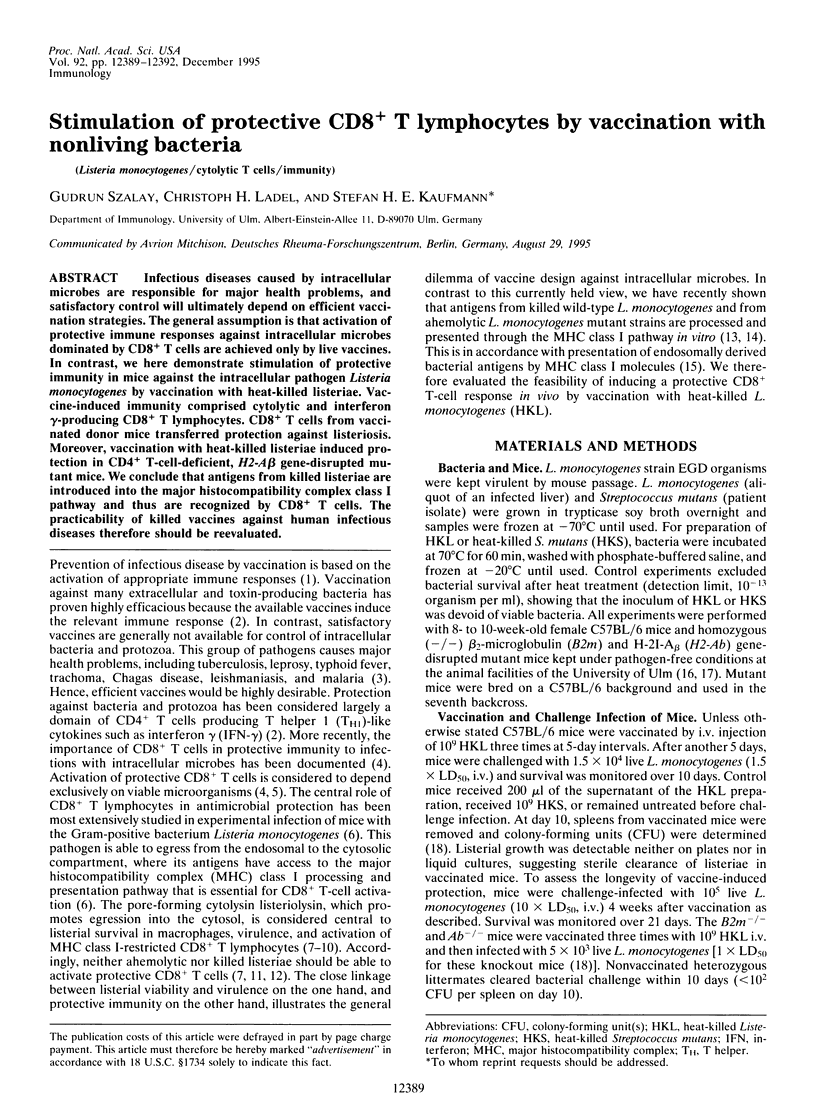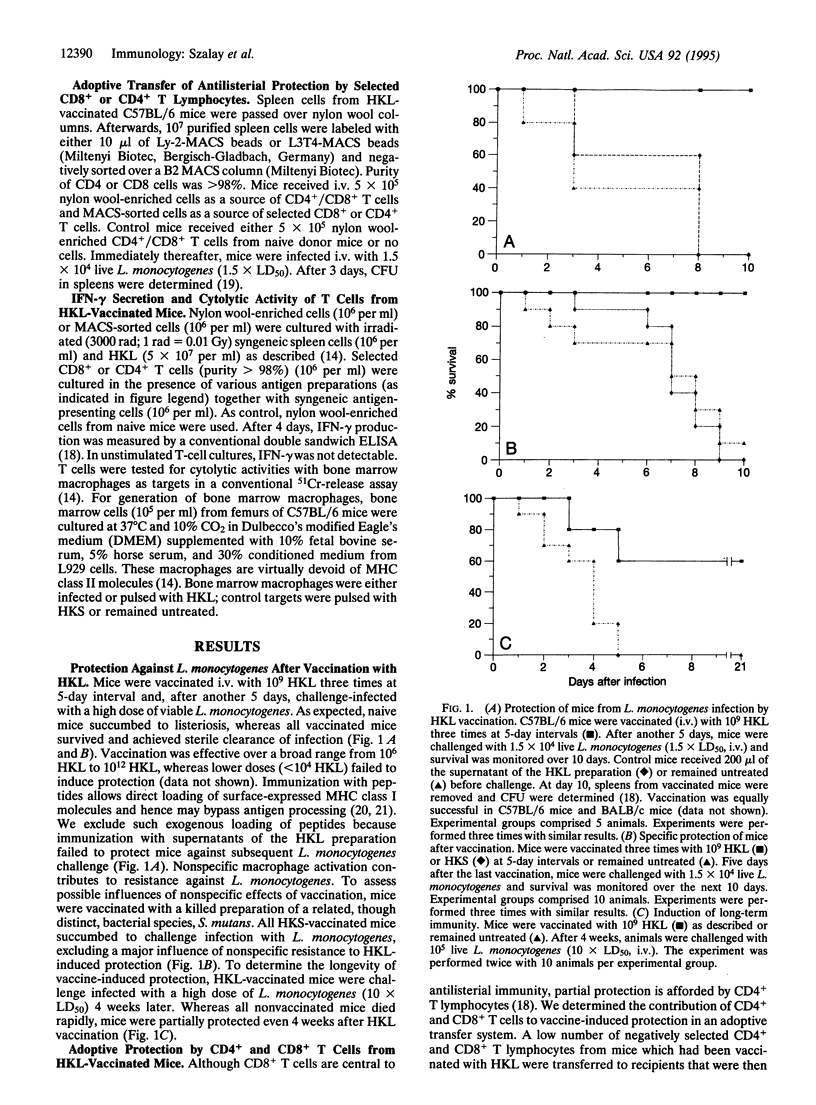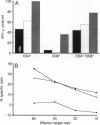Abstract
Infectious diseases caused by intracellular microbes are responsible for major health problems, and satisfactory control will ultimately depend on efficient vaccination strategies. The general assumption is that activation of protective immune responses against intracellular microbes dominated by CD8+ T cells are achieved only by live vaccines. In contrast, we here demonstrate stimulation of protective immunity in mice against the intracellular pathogen Listeria monocytogenes by vaccination with heat-killed listeriae. Vaccine-induced immunity comprised cytolytic and interferon gamma-producing CD8+ T lymphocytes. CD8+ T cells from vaccinated donor mice transferred protection against listeriosis. Moreover, vaccination with heat-killed listeriae induced production in CD4+ T-cell-deficient, H2-A beta gene-disrupted mutant mice. We conclude that antigens from killed listeriae are introduced into the major histocompatibility complex class I pathway and thus are recognized by CD8+ T cells. The practicability of killed vaccines against human infectious diseases therefore should be reevaluated.
Full text
PDF



Images in this article
Selected References
These references are in PubMed. This may not be the complete list of references from this article.
- Arnon R., Horwitz R. J. Synthetic peptides as vaccines. Curr Opin Immunol. 1992 Aug;4(4):449–453. doi: 10.1016/s0952-7915(06)80037-3. [DOI] [PubMed] [Google Scholar]
- Bachmann M. F., Kündig T. M., Freer G., Li Y., Kang C. Y., Bishop D. H., Hengartner H., Zinkernagel R. M. Induction of protective cytotoxic T cells with viral proteins. Eur J Immunol. 1994 Sep;24(9):2228–2236. doi: 10.1002/eji.1830240944. [DOI] [PubMed] [Google Scholar]
- Brunt L. M., Portnoy D. A., Unanue E. R. Presentation of Listeria monocytogenes to CD8+ T cells requires secretion of hemolysin and intracellular bacterial growth. J Immunol. 1990 Dec 1;145(11):3540–3546. [PubMed] [Google Scholar]
- Carbone F. R., Bevan M. J. Class I-restricted processing and presentation of exogenous cell-associated antigen in vivo. J Exp Med. 1990 Feb 1;171(2):377–387. doi: 10.1084/jem.171.2.377. [DOI] [PMC free article] [PubMed] [Google Scholar]
- Cosgrove D., Gray D., Dierich A., Kaufman J., Lemeur M., Benoist C., Mathis D. Mice lacking MHC class II molecules. Cell. 1991 Sep 6;66(5):1051–1066. doi: 10.1016/0092-8674(91)90448-8. [DOI] [PubMed] [Google Scholar]
- De Libero G., Kaufmann S. H. Antigen-specific Lyt-2+ cytolytic T lymphocytes from mice infected with the intracellular bacterium Listeria monocytogenes. J Immunol. 1986 Oct 15;137(8):2688–2694. [PubMed] [Google Scholar]
- Falo L. D., Jr, Kovacsovics-Bankowski M., Thompson K., Rock K. L. Targeting antigen into the phagocytic pathway in vivo induces protective tumour immunity. Nat Med. 1995 Jul;1(7):649–653. doi: 10.1038/nm0795-649. [DOI] [PubMed] [Google Scholar]
- Gaillard J. L., Berche P., Sansonetti P. Transposon mutagenesis as a tool to study the role of hemolysin in the virulence of Listeria monocytogenes. Infect Immun. 1986 Apr;52(1):50–55. doi: 10.1128/iai.52.1.50-55.1986. [DOI] [PMC free article] [PubMed] [Google Scholar]
- Hahn H., Kaufmann S. H. The role of cell-mediated immunity in bacterial infections. Rev Infect Dis. 1981 Nov-Dec;3(6):1221–1250. doi: 10.1093/clinids/3.6.1221. [DOI] [PubMed] [Google Scholar]
- Harty J. T., Bevan M. J. CD8+ T cells specific for a single nonamer epitope of Listeria monocytogenes are protective in vivo. J Exp Med. 1992 Jun 1;175(6):1531–1538. doi: 10.1084/jem.175.6.1531. [DOI] [PMC free article] [PubMed] [Google Scholar]
- Hosaka Y., Sasao F., Yamanaka K., Bennink J. R., Yewdell J. W. Recognition of noninfectious influenza virus by class I-restricted murine cytotoxic T lymphocytes. J Immunol. 1988 Jan 15;140(2):606–610. [PubMed] [Google Scholar]
- Hsieh C. S., Macatonia S. E., Tripp C. S., Wolf S. F., O'Garra A., Murphy K. M. Development of TH1 CD4+ T cells through IL-12 produced by Listeria-induced macrophages. Science. 1993 Apr 23;260(5107):547–549. doi: 10.1126/science.8097338. [DOI] [PubMed] [Google Scholar]
- Janeway C. Synthetic vaccines. Peptides of fortune. Nature. 1991 Oct 31;353(6347):792–792. doi: 10.1038/353792a0. [DOI] [PubMed] [Google Scholar]
- Kaufmann S. H. CD8+ T lymphocytes in intracellular microbial infections. Immunol Today. 1988 Jun;9(6):168–174. doi: 10.1016/0167-5699(88)91292-3. [DOI] [PubMed] [Google Scholar]
- Kaufmann S. H. Immunity to intracellular bacteria. Annu Rev Immunol. 1993;11:129–163. doi: 10.1146/annurev.iy.11.040193.001021. [DOI] [PubMed] [Google Scholar]
- Kaufmann S. H., Ladel C. H. Application of knockout mice to the experimental analysis of infections with bacteria and protozoa. Trends Microbiol. 1994 Jul;2(7):235–242. doi: 10.1016/0966-842x(94)90628-9. [DOI] [PubMed] [Google Scholar]
- Kaufmann S. H., Rodewald H. R., Hug E., De Libero G. Cloned Listeria monocytogenes specific non-MHC-restricted Lyt-2+ T cells with cytolytic and protective activity. J Immunol. 1988 May 1;140(9):3173–3179. [PubMed] [Google Scholar]
- Kovacsovics-Bankowski M., Rock K. L. A phagosome-to-cytosol pathway for exogenous antigens presented on MHC class I molecules. Science. 1995 Jan 13;267(5195):243–246. doi: 10.1126/science.7809629. [DOI] [PubMed] [Google Scholar]
- Ladel C. H., Flesch I. E., Arnoldi J., Kaufmann S. H. Studies with MHC-deficient knock-out mice reveal impact of both MHC I- and MHC II-dependent T cell responses on Listeria monocytogenes infection. J Immunol. 1994 Oct 1;153(7):3116–3122. [PubMed] [Google Scholar]
- Moore M. W., Carbone F. R., Bevan M. J. Introduction of soluble protein into the class I pathway of antigen processing and presentation. Cell. 1988 Sep 9;54(6):777–785. doi: 10.1016/s0092-8674(88)91043-4. [DOI] [PubMed] [Google Scholar]
- Pamer E. G., Harty J. T., Bevan M. J. Precise prediction of a dominant class I MHC-restricted epitope of Listeria monocytogenes. Nature. 1991 Oct 31;353(6347):852–855. doi: 10.1038/353852a0. [DOI] [PMC free article] [PubMed] [Google Scholar]
- Pfeifer J. D., Wick M. J., Roberts R. L., Findlay K., Normark S. J., Harding C. V. Phagocytic processing of bacterial antigens for class I MHC presentation to T cells. Nature. 1993 Jan 28;361(6410):359–362. doi: 10.1038/361359a0. [DOI] [PubMed] [Google Scholar]
- Portnoy D. A., Jacks P. S., Hinrichs D. J. Role of hemolysin for the intracellular growth of Listeria monocytogenes. J Exp Med. 1988 Apr 1;167(4):1459–1471. doi: 10.1084/jem.167.4.1459. [DOI] [PMC free article] [PubMed] [Google Scholar]
- Rabinovich N. R., McInnes P., Klein D. L., Hall B. F. Vaccine technologies: view to the future. Science. 1994 Sep 2;265(5177):1401–1404. doi: 10.1126/science.7521064. [DOI] [PubMed] [Google Scholar]
- Schirmbeck R., Böhm W., Reimann J. Injection of detergent-denatured ovalbumin primes murine class I-restricted cytotoxic T cells in vivo. Eur J Immunol. 1994 Sep;24(9):2068–2072. doi: 10.1002/eji.1830240920. [DOI] [PubMed] [Google Scholar]
- Staerz U. D., Karasuyama H., Garner A. M. Cytotoxic T lymphocytes against a soluble protein. Nature. 1987 Oct 1;329(6138):449–451. doi: 10.1038/329449a0. [DOI] [PubMed] [Google Scholar]
- Stover C. K. Recombinant vaccine delivery systems and encoded vaccines. Curr Opin Immunol. 1994 Aug;6(4):568–571. doi: 10.1016/0952-7915(94)90143-0. [DOI] [PubMed] [Google Scholar]
- Szalay G., Hess J., Kaufmann S. H. Presentation of Listeria monocytogenes antigens by major histocompatibility complex class I molecules to CD8 cytotoxic T lymphocytes independent of listeriolysin secretion and virulence. Eur J Immunol. 1994 Jul;24(7):1471–1477. doi: 10.1002/eji.1830240703. [DOI] [PubMed] [Google Scholar]
- Tang D. C., DeVit M., Johnston S. A. Genetic immunization is a simple method for eliciting an immune response. Nature. 1992 Mar 12;356(6365):152–154. doi: 10.1038/356152a0. [DOI] [PubMed] [Google Scholar]
- Yewdell J. W., Bennink J. R., Hosaka Y. Cells process exogenous proteins for recognition by cytotoxic T lymphocytes. Science. 1988 Feb 5;239(4840):637–640. doi: 10.1126/science.3257585. [DOI] [PubMed] [Google Scholar]
- Zijlstra M., Bix M., Simister N. E., Loring J. M., Raulet D. H., Jaenisch R. Beta 2-microglobulin deficient mice lack CD4-8+ cytolytic T cells. Nature. 1990 Apr 19;344(6268):742–746. doi: 10.1038/344742a0. [DOI] [PubMed] [Google Scholar]
- van Dijk H., Hofhuis F. M., Berns E. M., van der Meer C., Willers J. M. Killed Listeria monocytogenes vaccine is protective in C3H/HeJ mice without addition of adjuvants. Nature. 1980 Aug 14;286(5774):713–714. doi: 10.1038/286713a0. [DOI] [PubMed] [Google Scholar]
- von Koenig C. H., Finger H., Hof H. Failure of killed Listeria monocytogenes vaccine to produce protective immunity. Nature. 1982 May 20;297(5863):233–234. doi: 10.1038/297233a0. [DOI] [PubMed] [Google Scholar]



